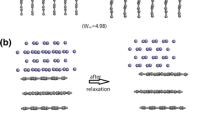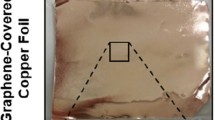Abstract
Super-high mechanical strength and excellent lubrication property at the nanoscale render graphene a promising ultra-thin solid lubricant. However, macroscale friction tests have shown that wear of graphene often occurs resulting in failure of interface lubrication. As graphene coatings are atomically thin, a sensitive and reliable detection method for monitoring wear has been a great challenge to date. In this work, we performed tribological experiments on monolayer graphene on SiO2/Si while simultaneously measuring the in-plane electric resistance of graphene during the sliding tests. Our experiments showed that the electric resistance exhibited a sudden increase signifying the onset of graphene wear well before the macroscale friction increased rapidly. The variation of in-plane electric resistance was found to depend on the wear track length and relative orientation. Longer wear track and wear track perpendicular to the current would typically lead to higher increase in graphene electric resistance. Our work demonstrates that monitoring in-plane electric resistance can be a simple, sensitive and predictive method for detecting graphene wear, which makes it a useful inspecting technique for a wide range of mechanical applications.
Similar content being viewed by others
References
Savage R H. Graphite lubrication. J Appl Phys, 1948, 19: 1–10
Talivaldis S. Lubrication with sputtered MoS2 films. NASA TM-67832. 1971
de Boer M P, Mayer T M. Tribology of MEMS. MRS Bull, 2001, 26: 302–304
Lee C, Wei X, Kysar J W, et al. Measurement of the elastic properties and intrinsic strength of monolayer graphene. Science, 2008, 321: 385–388
Lee C, Li Q, Kalb W, et al. Frictional characteristics of atomically thin sheets. Science, 2010, 328: 76–80
Klemenz A, Pastewka L, Balakrishna S G, et al. Atomic scale mechanisms offriction reduction and wear protection by graphene. Nano Lett, 2014, 14: 7145–7152
Qi Y, Liu J, Zhang J, et al. Wear resistance limited by step edge failure: The rise and fall of graphene as an atomically thin lubricating material. ACS Appl Mater Interfaces, 2017, 9: 1099–1106
Kim K S, Lee H J, Lee C, et al. Chemical vapor deposition-grown graphene: The thinnest solid lubricant. ACS Nano, 2011, 5: 5107–5114
Marchetto D, Held C, Hausen F, et al. Friction and wear on single-layer epitaxial graphene in multi-asperity contacts. Tribol Lett, 2012, 48: 77–82
Berman D, Deshmukh S A, Sankaranarayanan S K R S, et al. Extraordinary macroscale wear resistance of one atom thick graphene layer. Adv Funct Mater, 2014, 24: 6640–6646
Huang Y, Yao Q, Qi Y, et al. Wear evolution ofmonolayer graphene at the macroscale. Carbon, 2017, 115: 600–607
Berman D, Erdemir A, Sumant A V. Few layer graphene to reduce wear and friction on sliding steel surfaces. Carbon, 2013, 54: 454–459
Won M S, Penkov O V, Kim D E. Durability and degradation mechanism of graphene coatings deposited on Cu substrates under dry contact sliding. Carbon, 2013, 54: 472–481
Pereira V M, Castro Neto A H. Strain engineering of graphene’s electronic structure. Phys Rev Lett, 2009, 103: 046801
Huang M, Pascal T A, Kim H, et al. Electronic-mechanical coupling in graphene from in situ nanoindentation experiments and multiscale atomistic simulations. Nano Lett, 2011, 11: 1241–1246
Chung M G, Kim D H, Lee H M, et al. Highly sensitive NO2 gas sensor based on ozone treated graphene. Sens Actuat B-Chem, 2012, 166–167: 172–176
Yang T, Wang W, Zhang H, et al. Tactile sensing system based on arrays of graphene woven microfabrics: Electromechanical behavior and electronic skin application. ACS Nano, 2015, 9: 10867–10875
Lin Y C, Lu C C, Yeh C H, et al. Graphene annealing: How clean can it be? Nano Lett, 2012, 12: 414–419
Ferrari A C, Meyer J C, Scardaci V, et al. Raman spectrum of gra-phene and graphene layers. Phys Rev Lett, 2006, 97: 187401
Liu N, Pan Z, Fu L, et al. The origin of wrinkles on transferred graphene. Nano Res, 2011, 4: 996–1004
Vasic B, Zurutuza A, Gajic R. Spatial variation of wear and electrical properties across wrinkles in chemical vapour deposition graphene. Carbon, 2016, 102: 304–310
Kim K S, Zhao Y, Jang H, et al. Large-scale pattern growth of gra-phene films for stretchable transparent electrodes. Nature, 2009, 457: 706–710
Li X, Zhu Y, Cai W, et al. Transfer of large-area graphene films for high-performance transparent conductive electrodes. Nano Lett, 2009, 9: 4359–4363
Bae S, Kim H, Lee Y, et al. Roll-to-roll production of 30-inch gra-phene films for transparent electrodes. Nat Nanotech, 2010, 5: 574–578
Chen J H, Jang C, Xiao S, et al. Intrinsic and extrinsic performance limits of graphene devices on SiO2. Nat Nanotech, 2008, 3: 206–209
Li X, Cai W, An J, et al. Large-area synthesis of high-quality and uniform graphene films on copper foils. Science, 2009, 324: 1312–1314
Yu Q, Jauregui L A, Wu W, et al. Control and characterization of individual grains and grain boundaries in graphene grown by chemical vapour deposition. Nat Mater, 2011, 10: 443–449
Nirmalraj P N, Lutz T, Kumar S, et al. Nanoscale mapping of electrical resistivity and connectivity in graphene strips and networks. Nano Lett, 2010, 11: 16–22
Kim Y, Yun H, Nam S G, et al. Breakdown of the interlayer coherence in twisted bilayer graphene. Phys Rev Lett, 2013, 110: 096602
Author information
Authors and Affiliations
Corresponding author
Additional information
This work was supported by the Fundamental Research Funds for the Central Universities of China (Grant No. SWU118027).
Electronic Supplementary Material
Rights and permissions
About this article
Cite this article
Huang, Y., Li, Q., Zhang, J. et al. Electric resistance as a sensitive measure for detecting graphene wear during macroscale tribological tests. Sci. China Technol. Sci. 64, 179–186 (2021). https://doi.org/10.1007/s11431-020-1631-4
Received:
Accepted:
Published:
Issue Date:
DOI: https://doi.org/10.1007/s11431-020-1631-4




